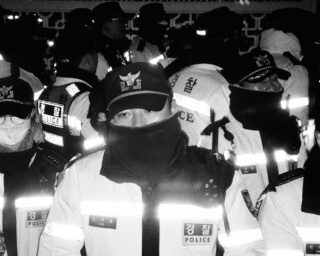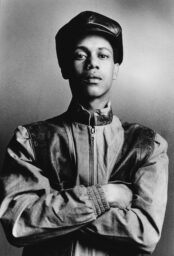Changing Paris
Mary Panzer reviews the Charles Marville exhibition at the Metropolitan Museum of Art, on view until May 4, 2014.
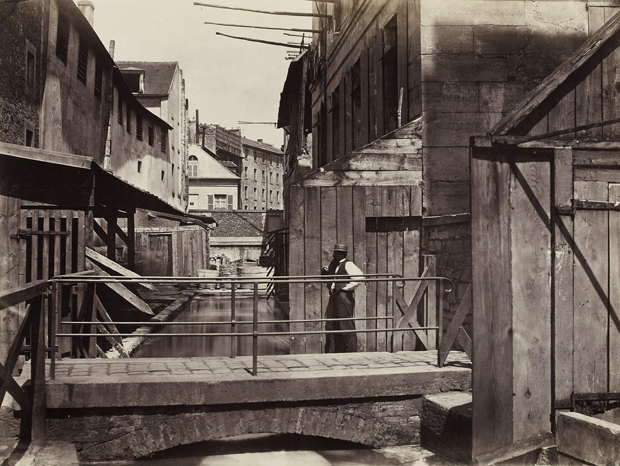
Charles Marville. Banks of the Bièvre River at the Bottom of the rue des Gobelins (Fifth Arrondissement) ca. 1862. © Musée Carnavalet / Roger-Viollet
Charles Marville (1813–79) has long been familiar to historians of photography and French architecture for his rich images of 1850s and 1860s Paris, much of which vanished during the massive redesign of the city organized by Baron Haussmann under Napoleon III. In many ways his success as a documentary photographer long made him nearly invisible as an innovator and artist. The current exhibition at New York’s Metropolitan (a collaborative effort by the National Gallery of Art in Washington; and the National Gallery of Canada, Ottawa) is the first large show devoted to Marville’s work, presenting a generous selection of original prints to contemporary audiences.
Marville was a successful illustrator who took up photography in the early 1850s and worked constantly until the end of this life. A year into his photographic career he began working for Louis-Désiré Blanquart-Evrard, whose Imprimerie Photographique was the first successful photography publisher in France. Marville’s skillful use of paper negatives (which allowed for multiple reproductions) rapidly turned him into the publisher’s main photographer. In 1861, he was appointed official photographer for the Louvre and recorded works of painting and sculpture, as well the institution’s architecture. He also photographed for sculptors and architects who sought records of their own work and of the structures that inspired them, including the historic Chartres Cathedral.
Most importantly, Marville worked for the city of Paris from 1862 to 1879: he documented neighborhoods slated for destruction, such as the tanneries on the banks of the Bièvres River; narrow, crumbling streets, some populated by fleeting figures; and epic scenes of destroyed government buildings, like the Hôtel de Ville. His pictures narrate urban transformation and the construction of all manner of new structures: the Opera, the expansive Bois de Boulougne park, as well as street lamps and public urinals (these may now strike us as antiquated but were then considered beacons of modernity). The exhibition also includes Marville’s documentation of the rough neighborhoods that emerged beyond the old city limits, home to the workers and migrants from the countryside who could not afford Haussmann’s modern city. These are the most surprising, and difficult, of the pictures on view. The Carrières d’Amérique (America Quarries) on a hill on the outskirts of the city, now Montmartre, was then a location for thieves, political dissidents, and gypsies—an ideal site for Haussmann’s cleansing plan.
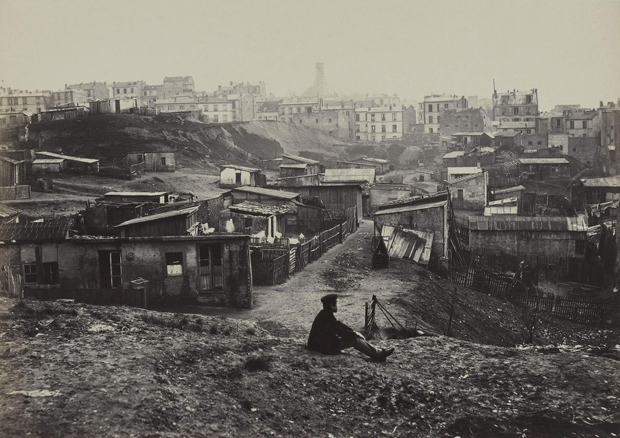
Charles Marville. Top of the rue Champlain, View to the Right (Twentieth Arrondissement) 1877–78. © Musée Carnavalet / Roger-Viollet
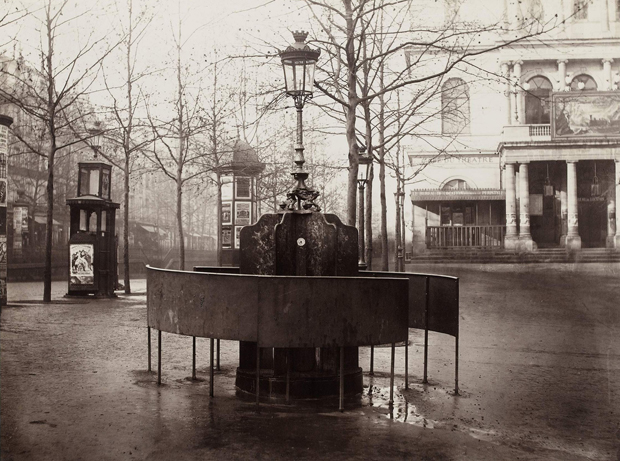
Charles Marville. Urinal, Jennings System, plateau de l’Ambigu 1876. © Musée Carnavalet / Roger-Viollet
What makes Marville’s work finally “visible” after remaining hidden in plain sight for over 150 years? Partly, we benefit from post-modernist enthusiasm for all kinds of photographic practices, including Marville’s commercial work. More importantly, we have learned about the way photographers have worked for the archive, creating images to serve posterity rather than solely for exhibition. The diligent, creative researchers who worked on this exhibition, led by Sarah Kennel of the National Gallery in Washington, have uncovered evidence that tells more than ever before about Marville’s assignments from Haussmann. What had been viewed as a clinical record of a rotting city slated for destruction, or a nostalgic look at structures about to vanish, had an altogether different purpose. From Françoise Reynaud, Curator of Photographs at the Musée Carnavalet, Paris, source for many images on view, we learn that Marville’s views of “Old Paris” were commissioned by Haussmann himself, who declared near the start of his modernization project that “the City of Paris must disregard nothing, forget nothing, neglect nothing of its past.” What had been considered visual proof of the need to destroy old buildings and modernize sewers turns out to be a diligent argument for their preservation—at least in the form of photographs.
Here, Haussmann follows the example of the 1851 Commission des Monuments Historiques, in which the French government selected five photographers to survey the nation’s architectural patrimony to determine the need for preservation and restoration. All of these photographers—Gustave Le Gray, August Mestral, Édouard Baldus, Henri Le Secq, and Hippolyte Bayard—have been celebrated for their artistic use of the camera; the project itself was highly romantic, a mournful retrospective focused on the ruins of an ancient civilization. Their salted paper prints, made with paper negatives, were rendered softly—a formal quality that intensified the celebration of the past. Marville himself had used this technology to great effect in his early work. A decade later, however, when he began his Paris survey, his images were meant to support progress and change and preserve the old city in a useful, accurate, and permanent form. Glass plate negatives, capable of rendering vast amounts of intricate detail, provided the right form for his enterprise; the crispness of the resulting albumen prints were widely associated with objectivity and modernity. This evolution is evident in the exhibition: the ninety-eight prints and three albums are organized chronologically and provide a rich, sensuous account of the transformation in photographic medium.
Revisiting Marville elicits questions of the more celebrated Eugène Atget, who carried his own, smaller, view camera through the same streets at another time of civic transformation—the turn of the twentieth century and its first two decades. Did Atget use Marville’s work as a guide? The Met addresses this question with an adjacent small show from the collection, Paris as Muse, in which work by Marville and Atget hangs alongside that of Daguerre, Stieglitz, Kertész, Brassaï, Ilse Bing, Henri Cartier-Bresson, and Man Ray. Seen together, these shows correct our view of Atget as a lone artistic genius, at the same time that they elevate Marville from servant to Haussmann to a sympathetic interpreter of the present, with an eye toward posterity.
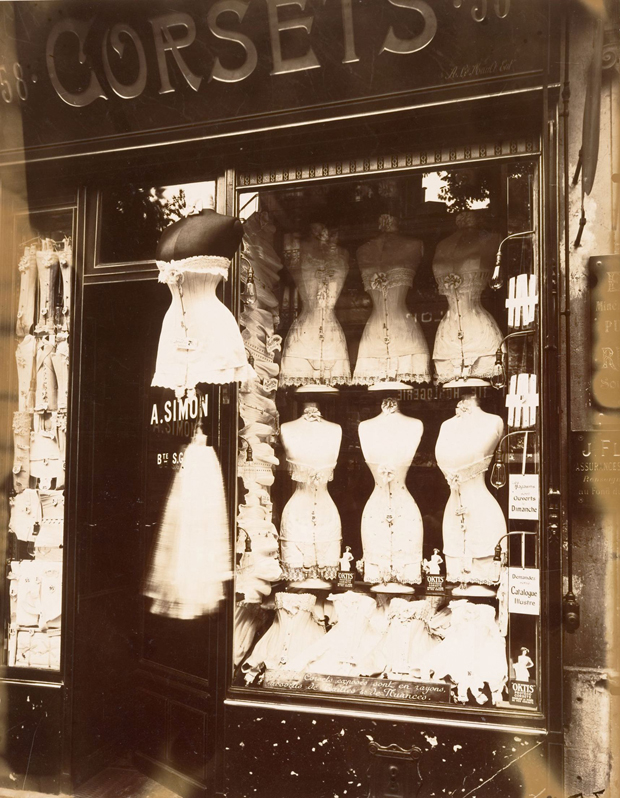
Eugène Atget. Boulevard de Strasbourg Corsets, Paris 1912. Gilman Collection, Purchase, Ann Tenenbaum and Thomas H. Lee Gift, 2005
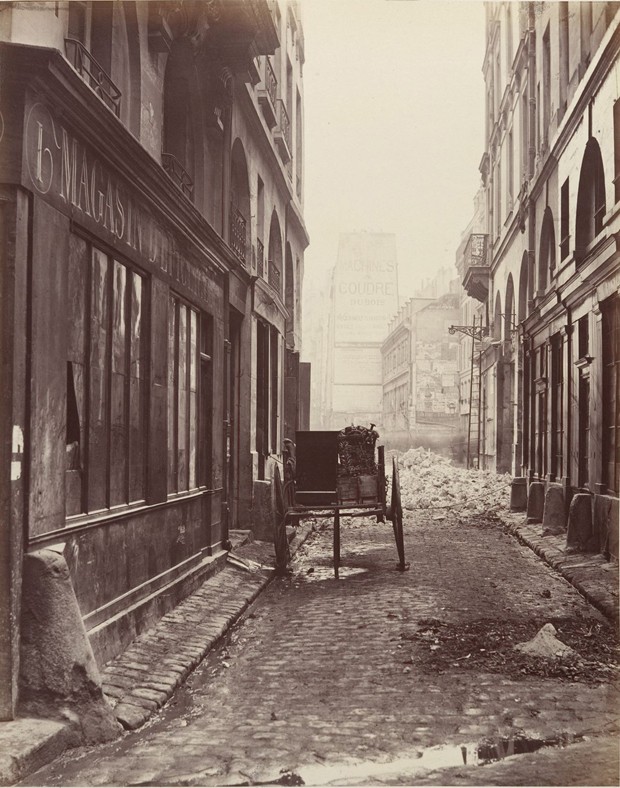
Charles Marville. Rue Estienne from the rue Boucher (First Arrondissement) 1862–65. The Metropolitan Museum of Art, New York
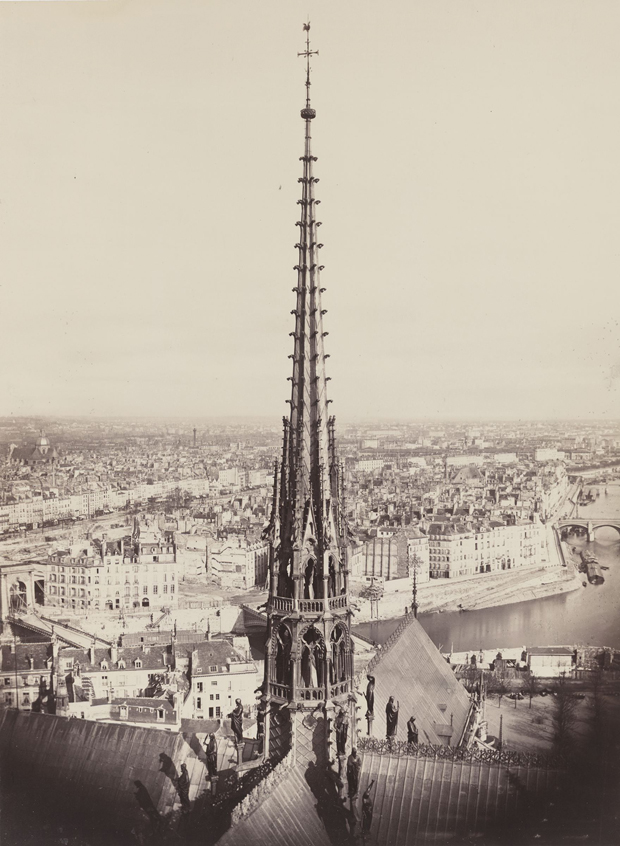
Charles Marville. Spire of Notre Dame, Viollet-le-Duc, Architect 1859–60. The AIA/AAF Collection, Prints and Photographs Division, Library of Congress, Washington D.C.
—
Mary Panzer is a photography writer and historian. She lives in New York.



















